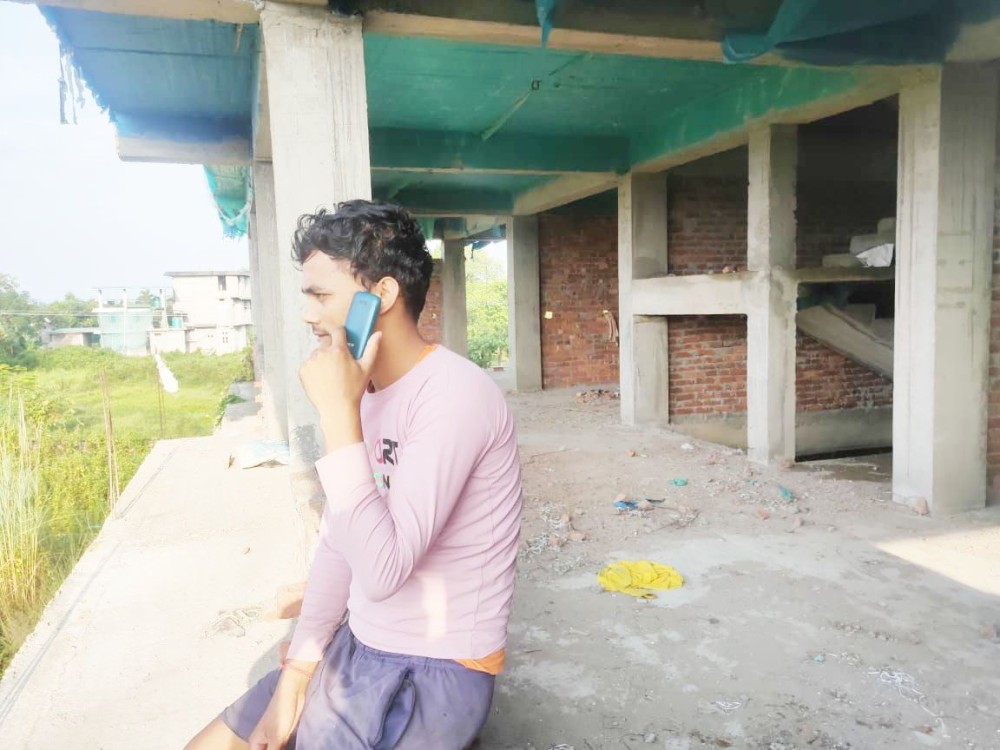A migrant labourer working in the construction sector in Dimapur is seen speaking to his family in Bihar over phone on October 8. From handwritten letters read aloud to mobile phones, the power of technology has bridged the gap between miles and brought people closer than ever before. (Morung Photo)

Imti Longchar
Dimapur | October 8
It’s a poignant moment for 76 year old Lal Bahahdur Shastri, a construction worker, who landed in Kohima in 1966 all the way from Jagdishpur village in Deoria, Uttar Pradesh- 1,358 km away, seeking a better life.
Shastri, as he is better known in the construction circuit, is finally bidding farewell to the state where he has spent most of his 57 years of life. The septuagenarian contractor has just completed his last construction project- a Church building at full Nagarjan. His eldest son, 43 year old Bhajuram has arrived from UP to escort his father back home to UP.
Shastri’s remarkable journey from his hometown to this far-off state, and the legacy he has built, paints a moving picture of the life of a migrant construction worker, who became an integral part of his adopted community.
Recollecting the circumstances of how he ventured into Nagaland, Shastri says he was informed by a relative through a letter about how construction workers were in demand in Kohima. He had never heard of Nagaland before. With no education and lack of amble opportunities at home, Shastri says he took a leap of faith.
“I began my first job as a labourer during the construction of the Kohima Science College hostel in 1966. At that time, a day’s wage for a labourer was Rs 3 and a full mistri (mason) received Rs 6,” Shastri recalls in an interaction with The Morung Express.
During the 5 decades of his time here in Nagaland, he would earn enough to educate all of his six children, marry off his three daughters and build a house in his hometown to call his own.
Shastri wistfully recalls the initial years of struggle in an unfamiliar place, “Despite having to go back home twice a year, I missed my home and family so much, at times I would just breakdown and cry.”
Unlike the present day where smartphones and video-calls have bridged the gap between miles and bring people together even when physically apart, in those days, the lines for communication were quite limited and the only lifeline during these times was the handwritten letters sent from his family by post.
“Every month I would eagerly await the arrival of my wife’s letters, which contained updates about our family and life at home. The letter day were the happiest moments,” Shastri reveals. During those years, it took 15 days for his letter to reach its destination in UP and another 15 days for the reply to reach him.
However, unable to read or write, he relied on fellow construction workers, who knew how to read, to decipher the letters to him or write it for him as he dictated. This monthly ritual became a cherished event, bringing workers together like a family household as they huddled around to listen to news from home.
“Those letters were everything to us. They were our connection to our families,” Shastri recalls with a nostalgic smile.
Decades flew by and Shastri relocated from Kohima to Dimapur seeking better prospects. Now a thekedar, Shastri has since then witnessed the upsurge of the migrant working community from different parts of India from hundreds to thousand fold, with some even making a home in the state.
“When I first moved to Nagaland, I never realized I would stay this long. Every earning I made in my lifetime has been from here. And for this opportunity, I am very grateful,” Shastri expresses adding, “I have earned enough so I didn’t have to struggle much nor my family back home.”
As a testament to the thousands of migrant workers who leave their homes in search of a better life and find not only livelihood but also a sense of belonging in distant places, the septuagenarian thekedar’s final words are, “I have had a good life here.”
‘Nagaland has better working conditions for migrants’
For migrant construction workers seeking better working conditions, Nagaland is considered as one of the best destinations in the country to earn a livelihood.
Nagaland’s appeal lies in a combination of factors which include shorter working hours, free access to lodging from contractors or project owners, a kinder and helpful local community and significantly less exploitation from contractors, claims migrant workers who have previously toiled in harsh working conditions and have found respite here.
48 years old Triphupan Prasad, who hails from Motihari, East Champaran in Bihar has been in Nagaland for more than 10 years. His wife and three children stay in Bihar and he sends Rs 10-15 thousand every month from his earning as a thekedar.
Before Nagaland, Triphupan tried his prospects as an unskilled labourer in Punjab. He lasted only a month. “Most of the employment opportunities were in the agricultural sector where you have to toil in the field under harsh open sky for 10- 12 hours. Besides getting the daily wages, there was not much opportunity to enhance one’s skill or grow, so I left Punjab and came to Nagaland.”
Ten years later, rising from an unskilled labourer to a thekedar in the construction sector, Triphupan has progressed in life. He has married off his daughter this year; his eldest son is in Kohima employed as small engine mechanics and the youngest studying in class 7 in Bihar.
Another migrant worker, Ganpat has faced similar experiences. Before coming to Nagaland, Ganpat had sought opportunities in Punjab and then in Haryana. In both the states, long working hours, exploitation by contractors and a sense of insecurity compelled him to try his prospects elsewhere.
“Unlike the practice here in Nagaland, construction owner in these states does not provide lodging for the workers. Even if it is makeshift or a properly build accommodation, we have to pay a rent,” he explains. And, we are compelled to work for at least 11-12 hours a day while here in Nagaland, working hours are more relaxed, he adds.
Since his departure from Haryana, Ganpat is already into his fifth year in Nagaland. He is now a full-fledged mason.
This is the 3rd report of a five-part series highlighting the experiences and challenges faced by the construction industry in Nagaland, as part of the Kohima Press Club and Nagaland Building and Other Construction Workers Welfare Board Media Fellowship 2023.






